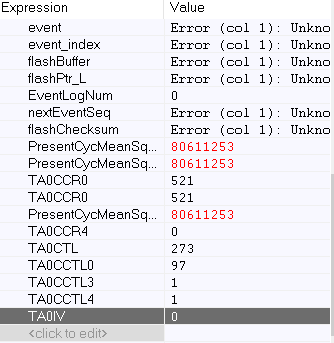Hi,
we are using MSP430F5437A for one of project. During initialization we made gpio port 8 as I/O and direction output. Is there any possibility for that port forcefully change that port selection to secondary purpose(TA0 timer interrupt registers) in the middle of program running and without involvement of program.
During TimerA0 initialization we made below configurations and stored 521 to TA0CCR0 register for ADC sampling purpose
Init timer1-A0 control registers for ADC sampling timer
*/
TA0CTL|= TASSEL_1; /* Clock Source: ACLK */
TA0CTL|= MC_1; /* Up mode */
TA0CTL|= TACLR; /* CLear timer counter */
/*
Init sampling timer period
*/
TA0CCR0= 521
/*
Enable timer Output mode set/reset
*/
TA0CCTL0|= OUTMOD_3; /* Out mode */
During debugging of code, we observed, apart from TA0CCTL0 all other control registers(TA0CCTL1 to TA0CCTL6) set to '1' once ADC interrupt service routine triggered in the code. This indicates capture/compare interrupt is pending, as per the data sheet. Is it expected those control registers set to 1 or it should not happen as in the code we didn't use those control registers in the initialisation.
Could you please let me know what is the exact meaning for P8.0/TA0.0 in the below table.
Below table is for your information.
Thanks,
Gourav



